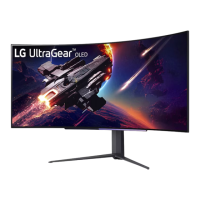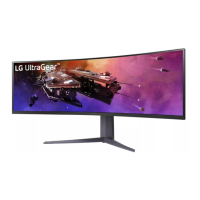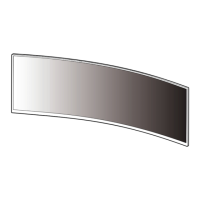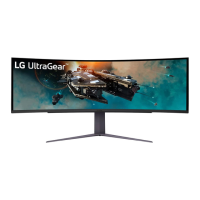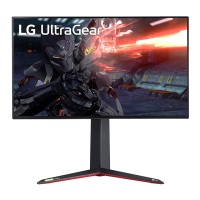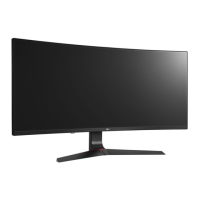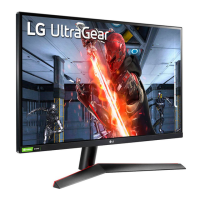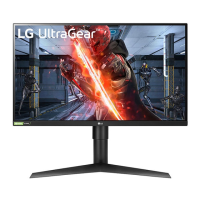Do you have a question about the LG UltraGear 45GS96QB and is the answer not in the manual?
Instructions for setting up the monitor, including safe moving and lifting procedures.
Details on placing the monitor on a table for proper ventilation and setup.
Guidance on connecting a security cable to prevent theft of the monitor.
Specifications and guidelines for mounting the monitor on a wall.
Steps for attaching the optional wall mount bracket to the monitor.
Overview of the monitor's physical features and the joystick button.
Detailed explanation of the joystick button's functions for navigation and control.
Instructions for adjusting the monitor's height for optimal viewing.
How to tilt and swivel the monitor screen for comfort.
Information on obtaining and installing necessary software and drivers.
How to connect the monitor to a computer using Plug and Play.
Transmitting digital video and audio signals via HDMI from a PC.
Transmitting digital video and audio signals via DisplayPort from a PC.
Connecting the monitor to a PC using a USB-C cable.
Connecting external audio-visual devices to the monitor.
Connecting various external devices to the monitor.
How to connect USB devices like keyboards and mice to the monitor.
Connecting headphones or headsets to the monitor's audio port.
Steps to access and navigate the monitor's on-screen display (OSD) menu.
Overview of the main menu options and their functions.
Guide to navigating and adjusting various settings within the OSD menu.
How to configure game-specific picture and performance settings.
Adjusting brightness, contrast, sharpness, and color settings.
Configuring audio output, volume, and special sound features.
Managing input sources, aspect ratios, and PBP/PIP modes.
Configuring language, screen saver, energy saving, and other system options.
Guidelines and settings to prevent image retention on OLED panels.
Important safety advice and potential long-term effects of OLED panel use.
Specifications for the power adapter and monitor power ratings.
Details on the monitor's maximum resolution and color depth support.
Recommended operating and storage temperature and humidity ranges.
Physical size and weight specifications of the monitor with and without the stand.
Table detailing supported resolutions, frequencies, and input versions for HDMI.
Table listing supported resolutions and frequencies for DisplayPort/USB-C.
Horizontal and vertical frequency specifications for various video resolutions via HDMI.
Steps to diagnose and resolve issues when the screen remains blank.
Solutions for unstable display, flickering, or shadow trails.
Explains the appearance of pixilated spots and their nature.
How to enable features that may be locked or unavailable.
Troubleshooting steps for audio not working through the headset port.
Details about product licenses and trademarks.
Information on obtaining and using open source software.
A reference guide mapping menu items to their page locations for quick lookup.
| Screen Size | 45 inches |
|---|---|
| Panel Type | OLED |
| Refresh Rate | 240 Hz |
| Response Time | 0.03ms (GtG) |
| Aspect Ratio | 21:9 |
| Curvature | 800R |
| Adaptive Sync | NVIDIA G-Sync Compatible, AMD FreeSync Premium Pro |
| Stand Adjustability | Height, Tilt, Swivel |
| Resolution | 3440 x 1440 |
| Brightness | 1000 nits |
| HDR | HDR10 |
| Connectivity | 2 x HDMI 2.1, 1 x DisplayPort 1.4, 1 x USB Hub |
| Color Gamut | DCI-P3 98.5% |
| Contrast Ratio | 1, 500, 000:1 |
| VESA Mount | 100 x 100 mm |


